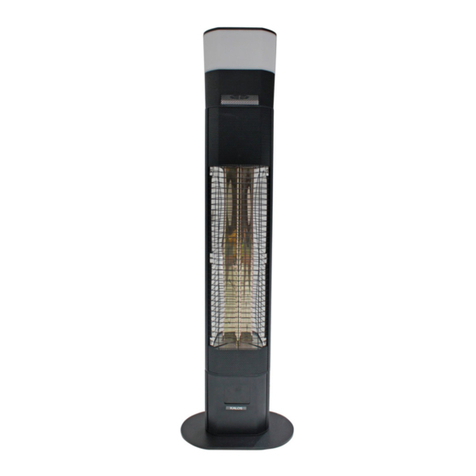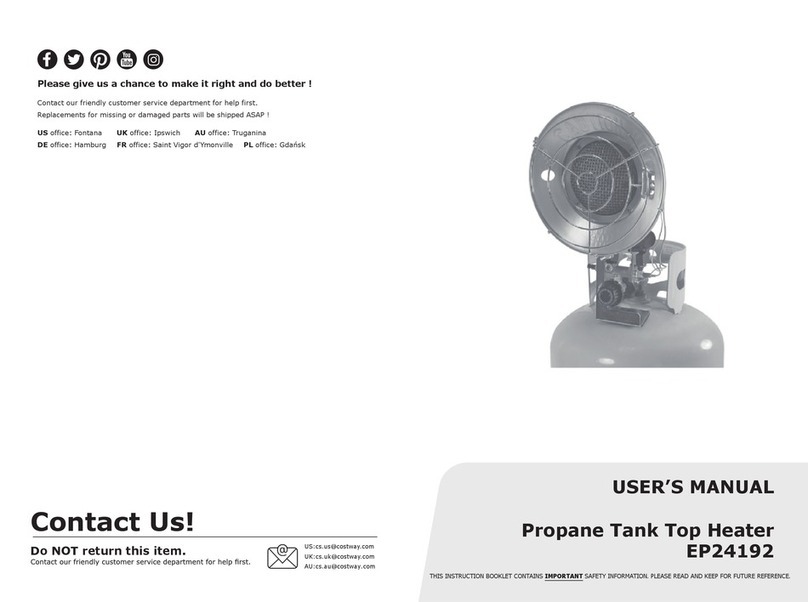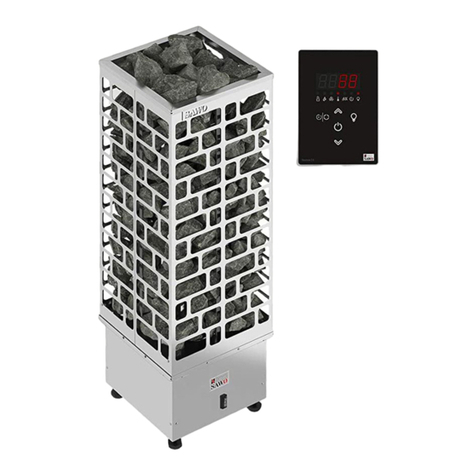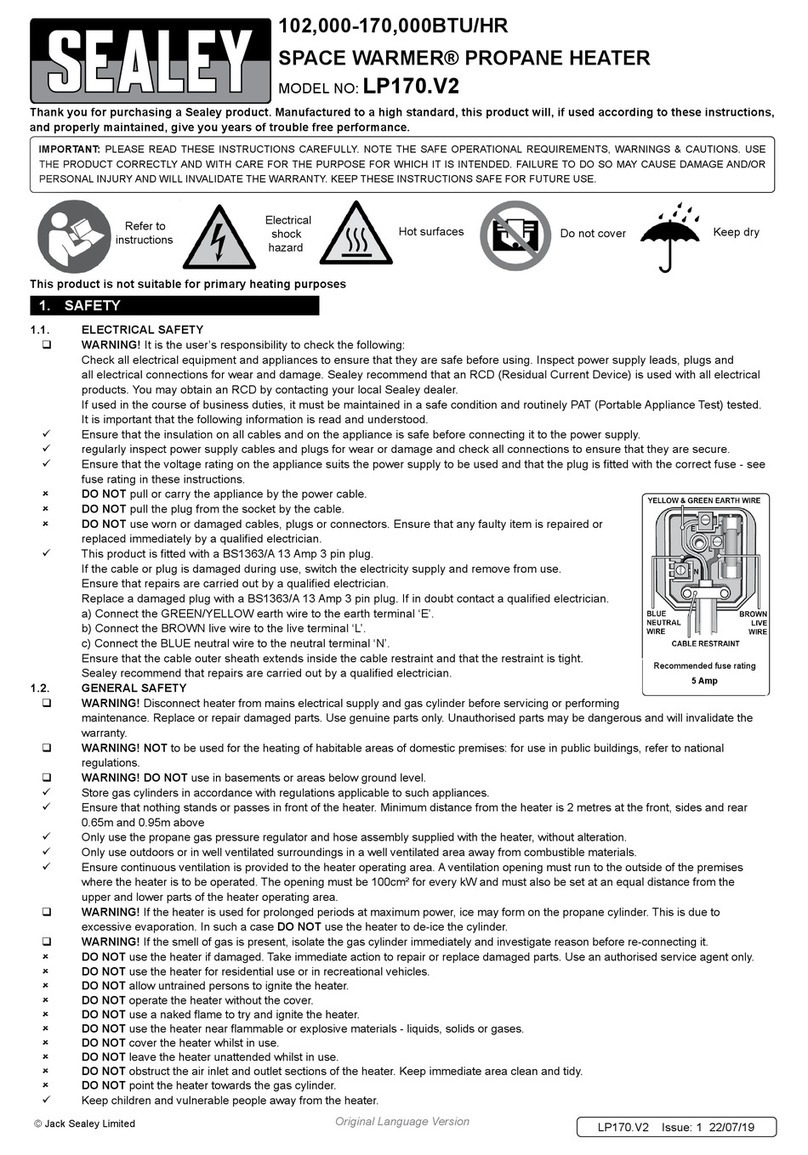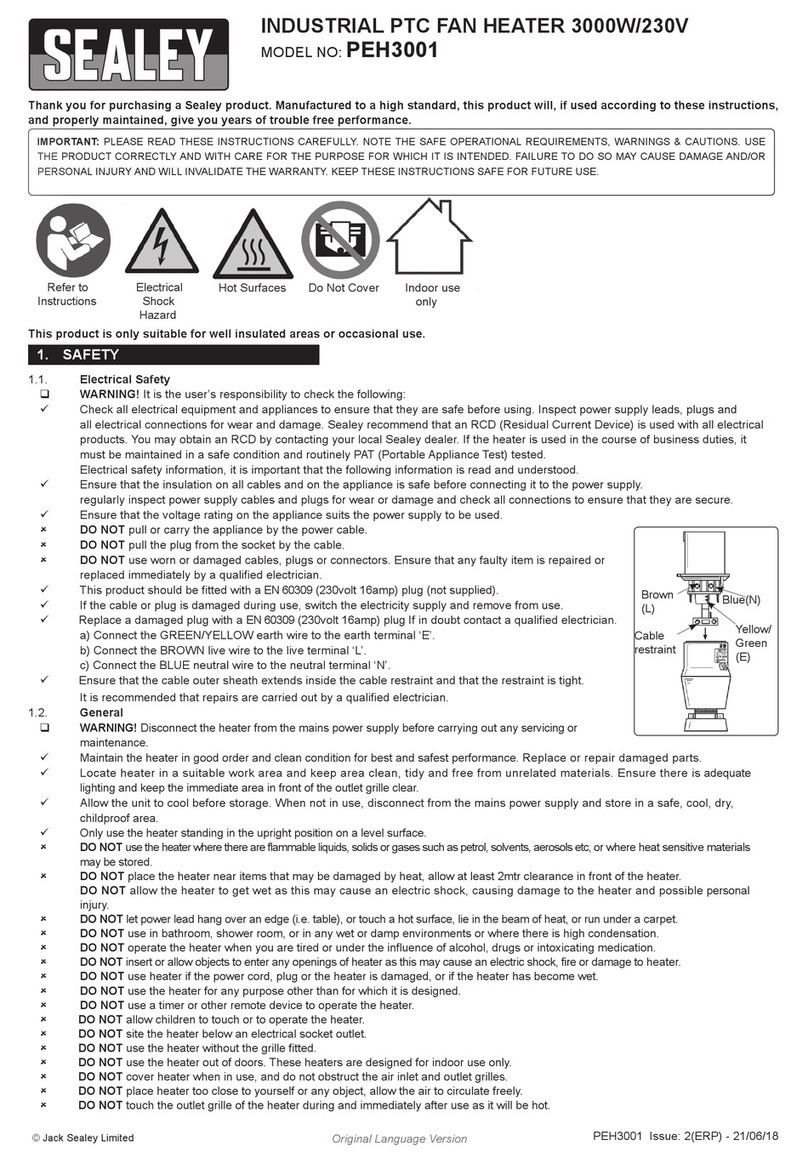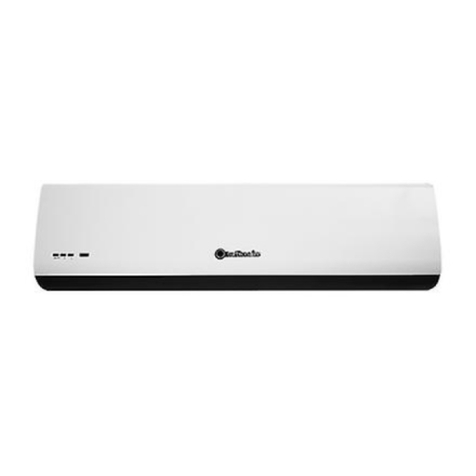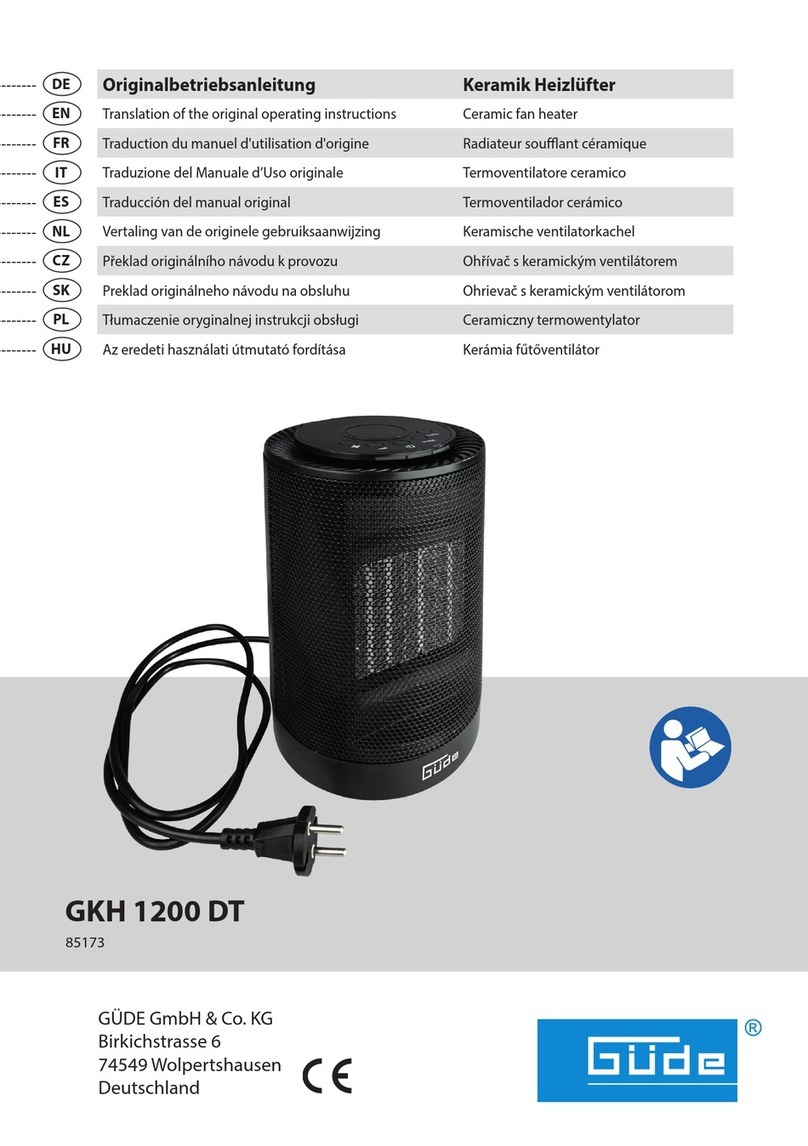Smart+ Products SPP-500-1WP Quick start guide

1
O
OW
WN
NE
ER
RS
S
I
IN
NS
ST
TA
AL
LL
LA
AT
TI
IO
ON
N
A
AN
ND
D
O
OP
PE
ER
RA
AT
TI
IN
NG
G
M
MA
AN
NU
UA
AL
L
SMART+ PRODUCTS Infrared Heater
Model: SPP-500-1WP
Safety Notice
Please read this entire Installation and Operating Manual BEFORE installing and using
your new Infrared Heater. Failure to fully understand and follow instructions may result in
property damage, bodily injury, or even death.
If the Infrared Heater in not used properly, a house fire may result. For everyone’s safety,
FOLLOW all Installation and Operating Directions.

2
Save These Instructions
TABLE OF CONTENTS
Topic Page(s)
Introduction & Specifications 3
Important Safety Information 4-5
Frequently Asked Questions 6-8
Heater Operation 9
Heater Placement 10
Users Guide 11
Air Filter Maintenance 12

3
INTRODUCTION
Thank you for choosing one of the best Infrared distribution heaters available on the
market today. Our Infrared Heater is a very safe and effective room heater. It produces
safe, clean and economical heat by utilizing quartz infrared heating elements. The heating
process of the Infrared Heater is similar to the way the sun warms the earth. The infrared
elements warm the heat chamber and the whisper quiet fan distributes the accumulated
warmth. This process is unique among heaters in that it minimizes wasteful heat collection
at the ceiling height of rooms and targets it toward the living space instead. Thank you for
being our customer, and enjoy your heater!
Our Infrared Heaters have been tested and listed for installation in residential and mobile homes
by ETL:
SPECIFICATIONS:
Electrical:
Voltage: 120V~60Hz,
Power consumption: 750/1500 Watts
Thermostat range: 50-90 Fahrenheit
Coverage:
Up to 750 square feet of unobstructed area
Dimensions:
16.5”x 13.2”x 16.5”, 25 lbs
Safety features:
Advanced Safety Overheat Shut Off
Features:
Remote Control
High/Low Heat Settings
Air filtration system
Lifetime Washable Filter

4
Run Timer
Eco Friendly Wood
IMPORTANT SAFETY INSTRUCTIONS
READ AND UNDERSTAND ALL INSTRUCTIONS, SAFETY WARNINGS,
AND FAQ’s BEFORE USING THE HEATER
WARNING!
! POTENTIAL FOR ELECTRICAL HAZARD IF NOT ADHERED TO!
When using electrical appliances, basic precautions should always be followed to reduce
the risk of fire, electric shock, and injury to persons, including the following:
1. This heater must be plugged into a 120V, 15 amp (or more) circuit of its own. Nothing
else can be plugged into the same circuit. If unsure if your home meets this
specification, consult a certified electrician prior to use. Risk of fire, overheat,
malfunction, property damage, injury, or even death may result if not adhered
to!
2. Connect to a properly grounded, 3-prong outlet only. Do not connect the heater to
extension cords, surge protectors, timers, direct breakers, or an outlet with other
appliances connected to the same outlet. Risk of fire, overheat, malfunction,
property damage, injury, or even death may result if not adhered to!
3. This heater is hot when in use. To avoid burns, do not let bare skin touch hot
surfaces. Use handles (certain models) or wheels to move this heater.
4. Keep combustible materials, such as furniture, pillows, bedding, papers, clothes, and
curtains from the front of the heater and keep them away from the sides and rear of
the heater.
5. Extreme caution is necessary when any heater is used by or near children, invalids,
pets, or when the heater is left operating unattended.
6. Always unplug the heater when not in use.
7. Do not operate any heater with a damaged cord or plug or after the

5
heater malfunctions, has been dropped, or damaged in any manner. Contact the
manufacturer for resolution options.
8. Do not use outdoors. Exposure to outdoor elements such as rain, snow, sun, wind or
extreme temperatures may cause the heater to become a safety hazard.
9. This heater is not intended for use in bathrooms, laundry areas and similar indoor
locations, nor any locations that use GFCI outlets.
10.Never place heater where it may fall into a bathtub or other water receptacles.
11.Do not run cord under carpet. Do not cover cord with throw rugs, runners, or similar
coverings. Arrange cord away from traffic area and where it will not be tripped over.
12.The heater must be plugged into a wall outlet that is a DEDICATED CIRCUIT, with a
minimum 15 amp rating on that individual circuit.
13.To disconnect the heater: FIRST, turn the power button to the “off”position, then
remove plug from the wall outlet.
14.Do not allow foreign objects to enter or block any ventilation or exhaust opening as
this may cause an electric shock or fire, or damage the heater.
15.Allow at least 3 feet of unobstructed space to the front and rear of the heater to allow
for maximum heat, air, and ventilation flow.
16.A heater has hot and arcing or sparking parts inside. Do not use it in areas where
gasoline, paint, or flammable liquids are used or stored, nor use flammable solvents to
clean the heater. Also, make sure to keep heater dry at all times.
17.Use this heater only as described in this manual. Any other use not recommended by
the manufacturer may cause fire, electric shock, or injury to persons.
18.Do not use abrasive solvents to clean the heater as it may cause damage to the finish
or casing.
PLEASE REVIEW FREQUENTLY ASKED QUESTIONS ON THE NEXT
FEW PAGES PRIOR TO USING YOUR HEATER.

6
FREQUENTLY ASKED QUESTIONS (FAQ’S)
My heater emits a “strange” odor when I first open the box/when I turn the heater on for the first time.
Why?
These are both normal. This heater is treated with a special heat safe/resistant coating. This
odor will sometimes be present when the box is opened, and may be compared to a heaters
version of “new car smell.” Also, similar to all hearth appliances (woodstoves, etc.), the coating,
exposed to heat, will produce this particular odor during the first few hours of operation. This will
dissipate after the break-in period. If you are sensitive to odors, you may want to pre-burn the
unit in a garage with the door open until the initial odor dissipates.
If my heater runs on approximately 1500 watts, how many BTU’s is that? Is that a lot of heat?
At 1500 Watts, your heater will use approximately 5100 BTUs. 5100 BTUs, compared to your home
furnace, is a very small amount of heat. It may take several minutes, to several hours to heat your
area, depending on various factors (see Heater Placement).
Can my heater really operate on less money per day? What are my operating costs?
Most Definitely. If the heater is used as it is intended (as supplement/assist heat), it should cycle
on and off, allowing for it to heat a total of approximately 8 out of the 24 hours of the day. Using the
national average of approximately 10¢ per kWh (look at your bill for exact cost per kWh--will vary
per state), your average heating cost should be less per day compared to your main furnace. The
costs will increase if it is used as the single source of heat, or if heat somehow escapes the room
being heated, since the “on” cycle will run longer.
The Formula: To determine the cost of this or ANY 1500 watt appliance, multiply 1.5 X your cost
per Kilowatt Hour. You can find the cost per KWH for your state at:
http://www.eia.doe.gov/fuelelectric.html
What is the life expectancy for the Heating Elements? Can the heating elements be replaced?
The life expectancy of the heating elements is typically 25,000 hours. Heating elements may be
replaced by obtaining parts from SMART+ PRODUCTS Products, although it is not recommended
(unless you are a certified heater technician or authorized directly by SMART+ PRODUCTS). All
parts may be purchased through SMART+ PRODUCTS PRODUCTS if your product is out of
warranty. Note: If you feel that the elements are definitely faulty right out of the box, contact

7
SMART+ PRODUCTS Products Tech Support first (for troubleshooting). Contact your place of
purchase second.
Once I plug the unit in and turn it on, how long will it take to heat my room?
Typically it takes about ½ hour to feel a temperature change. Please remember that with any type
of heating process, there are many variables: Location (in the home), floor plan and size of the
room, how well the room is insulated, how many doors/windows, how much bare concrete (acts as
a heat sink with any type of heating), the opening and closing of an exterior door, long hallways,
high ceilings, etc. Customers with smaller rooms experience quick heat changes. Others with larger
and open floor plans can expect up to 24 hours to heat up.
I don’t have a grounded outlet; can I use adapters, a 2-prong power strip, or remove the ground
prong from the cord?
Definitely NOT! If you don’t have a grounded outlet, contact a certified electrician for advice.
Removing or altering any part of the heater’s original design or intent (including the power cord) will
not only void the warranty, but will make you liable for any unexpected or hazardous results.
Why doesn’t the temperature on my heater match the temperature display on my wall, or external
thermostat?
This is completely normal. The temperature display on your heater may vary from the
temperature display on another thermostat (like the one mounted to your wall or a purchased
external thermostat). The temperature sensor on your heater reads the temperature in, and around,
the heater. The unit is near the cold floor (and heat rises), which in turn, will display a cooler
temperature than elevated or external thermostats. The best way to operate your heater is just to
set the unit on “High” and dial up to a temperature that feels comfortable to you. Then, leave it at
that temperature, regardless of the mismatch. The heater will cycle off when the set temperature is
met or exceeded slightly.
I don’t have a grounded outlet; can I use adapters, a 2-prong power strip, or remove the ground prong
from the cord?
Definitely NOT! If you don’t have a grounded outlet, contact a certified electrician for advice.
Removing or altering any part of the heater’s original design or intent (including the power cord) will
not only void the warranty, but will make you liable for any unexpected or hazardous results.
My home is not insulated very well, will this heater help me? Can I use the heater if I have vaulted or
cathedral ceilings? I live in a structure that is less than 1500 square feet. Will this heater help me? Can I
use the heater to heat multiple rooms at the same time? Will I be able to use the heater in a basement or
garage?

8
The answer to these is the same. Yes. You will be able to use it, but keep in mind that
rooms/structures with open floor plans, minimal insulation, adjacent rooms, or high ceilings will not
retain the heat as efficiently, and may not feel pronounced heat changes. Also, the heater will stay
on longer (delays the “off” cycle), and may increase your electric costs. Note that if you do use it in
a garage or basement, the moisture levels must be very low and they must have dedicated circuits
(15 amps minimum) with no GFCI outlets. If unsure what a GFCI outlet is, contact a certified
electrician.
Can I use more than one heater at a time? Can I use the heater and another appliance at the same time?
Yes. But make sure they are not plugged into the same circuit. Each heater (heaters are
considered appliances) requires its own minimum15 amp circuit (with no other items plugged
into that circuit). If unsure your circuit meets these requirements, verify with a certified electrician.
Risk of fire, damage to property, or injury may result if requirements are not met.
Why does my heater’s fan continue to run even after the set temperature is reached or the power is
turned off?
This is normal. The heater’s fan will continue to run, even after the heater automatically cycles
down. The fan continues to run so that every last bit of heat is blown out of the heat chamber, while
allowing the unit to continue filtering your air. Once the internal box/components cool completely,
the fan should then shut off on its own
My fan runs at all times, even when the heat has cycled off. Why?
This is normal. Although the heat cycles off, the fan stays on until the chamber is cool. If the
temperature falls below the desired set temperature during the time the fan is cooling, the heating
elements will cycle back on. This will not allow for the fan to completely cool off the chamber, and
shut down. The fan seems to run continuously. It is a safety mechanism to prevent overheating.
The best way to avoid this is to have the set temperature at least 5 degrees higher than the desired
heat, so that it retains that heat during the cooling cycle.
Why doesn’t the fan speed increase when I change the setting from LO to HI?
This is normal. The heater’s fan’s speed is not affected by the HI/LO settings. The fan is designed
to vent the heat at one soft, comfortable, and energy efficient speed. What is affected by the HI
setting is the heat output. In essence, in the HI mode, the heater produces “more” heat, rather than
“faster” heat.
My heater does not perform as well as another brand heater that I purchased. Why Not?
There are many brands of heaters on the market. Each brand is designed with different heat
specifications, fan speeds, colors, material types, displays, and electrical components. They are
manufactured this way for you, as the consumer to have choices, selection, and preferences. As
long as the unit functions as specifications indicate, comparison to other brands will ultimately
depend on individual consumer perception.
I purchased my heater so that it could cut my heating costs, but my electric bill has gone up. Why?
The compact SMART+ PRODUCTS heater can definitely save you on heating costs, when
compared to the existing central heating system in place in your home, and when used as directed.
Your heater is designed to give your main heat source a supplement “boost,” or allow for you
to have extra heat (in the form of soft infrared waves) in locations where you would otherwise

9
be short. It is meant to cycle on and off, and not specifically designed to be used as a single heat
source, especially in larger homes. If you intend on using it as a single heat source (which you
may), expect the heater to 1) take as much as 24 hours to heat the area, 2) stay on for longer
periods of time (without cycling off) due to heat loss, and 3) increased use time, and electric costs.
My heater’s display shows my ambient temperature to be in the 20’s, when I know it is warmer than that.
Why?
The heater’s display is defaulted to read the temperature as Fahrenheit. If your heater is definitely
heating, but shows it is in the 20’s, you probably have the setting to read your temperature in
Celsius, rather than Fahrenheit. See Users Guide to change.
HEATER OPERATION
Here is a small description of how our heaters work:
Operation Mechanism:
1) Air is brought into the heater through an easy to clean, washable filter at the rear of the
unit.
2) The highly efficient, one-speed, high volume fan pushes filtered air through the chamber,
across the heat elements.
3) During this exchange, heat is accumulated and transferred to the air in the chamber.
4) The newly transferred filtered, clean, and hot air is then circulated out the infrared
heater’s front vent.

10
5) The whole process produces variably hot air, compared to the air originally entering the
heater.
6) This method of heat generation creates an even, comfortable level of infrared heat from
floor to ceiling (as opposed to venting hot air blowing that will just rise to the ceiling and
dissipate)
There is no drying of the air with this method of heating and no harmful chemicals or pollutants
are released.
HEATER PLACEMENT
By using this infrared heater you can efficiently heat up to 1500 of unobstructed square
feet. This heater is NOT intended to replace your home’s furnace. Rather, it is designed to
be a supplement to it. It is not an instant heater, and on occasions (depending on various
factors), can take up to 24 hours for a room to reach the desired temperature. Your
Infrared Heater is equipped with a lifetime washable static filter system which removes
airborne contaminates as air circulates into the heating chamber.
To achieve maximum efficiency of your Infrared Heater, please follow these
recommendations:
1. Place your Infrared Heater at least 3 feet from an “inside”wall (a wall that is away
from the cold, outside perimeter of your house) of the room in which it will be
used. Face the heater’s exhaust vent (the grill) toward the cooler “outside” walls

11
Control Panel
Remote Control
of the room. This positioning will allow the heat to be moved across the room toward
the outside walls to provide more even warmth throughout the room.
2. Make sure that windows and doors are not allowing a high rate of airflow into the room
where you will be placing your heater. High airflow will minimize the effectiveness of
your Infrared heater, as it would any conventional type heater.
3. For best results, always try to maintain a minimum of 40% relative humidity in the
environment to be heated.
4. It is recommended that the Infrared heater be used in rooms that are insulated according
to code. You can use your heater in a room whether insulated or not, but a non-
insulated room will cause greater and faster heat loss which is counterproductive, and
will keep the heater in the “on” cycle longer. This may increase your electricity costs.
5. Keep the area around the heater clear of clutter and obstacles so that there is free
airflow to and from the heater.
6. Make sure to keep your heater out of the main traffic area of the room in which it is
located; it should be a welcome addition to the room rather than an obstacle to be
stepped over or stepped around.
USER’S GUIDE
Plug your Infrared Heater power cord into a 120V,
15amp (or higher) three-prong receptacle.
To Turn the Heater On: Turn the power switch on in
the back of the heater, and press the Power button
on the front control panel or on the remote
control.
Default Set Temperature: The default set
temperature every time the heater is powered on is
typically 72°. This can not be changed. You will have
to set it accordingly every time you power it off.
Ambient Temperature: To view the ambient room
temperature, press the up and down

12
buttons at the same time, the room temperature will display for 5 seconds then return to the
desired set temperature.
To Set Desired Temperature:
Press the UP or DOWN button on the control panel or on the remote control. When
the desired set temperature is reached by the heater’s internal thermostat, the heater will stop
heating automatically, but the fan will continue to run for approximately 5 minutes (3 minutes
when powered off) so that unit’s chamber can cool. When the ambient temperature drops below
the set desired temperature, the heater will cycle on again.
To Set Heat Level: Press the heat button on the control panel or remote control to switch
between High and Low heat. The corresponding High (H) or Low (L) light will switch on. In the
High mode, the fan will not change speeds. Rather, the heating elements will allow for higher
heat output. The High level uses 1500 watts, while Low heat level uses approximately 750
watts.
The Run Timer: For your convenience, our heater also comes with a built in timer. This is a
function that allows for you to set how long you would like the heater to stay on (and cycle), then
automatically power off.
To Set Run Timer: Press on the control panel or remote control. Numbers from 0 to 8 will
appear as options on the display. Each number represents countdown hours. 0 means there is
no set hour, and the heater will run (and cycle) until you manually power it off. Numbers 1-8 are
the number of hours available for the heater to run before it powers off. Select the timer hour
number by pressing to select 0-8. The display will revert back to the temperature (on its
own) within 5 seconds of button inactivity.
Celsius and Fahrenheit: The heater displays temperature in Fahrenheit as the default, but has
the capability to display it in Celsius as well.
To change between °Celsius and °Fahrenheit: Press
FILTER MAINTENANCE
Your Infrared Heater is equipped with an easy to clean, washable static filter. Regular cleaning
and maintenance of your filter will ensure a lifetime of trouble-free use.
1. Turn off the heater. Locate the filter at the rear of the heater and lift out (some filters may be
held on by brackets. Others may be magnetic. Others may require loosening up some

13
screws).
2. Rinse the filter by spraying warm tap water through the filter. Make sure the water is sprayed
into the side that faces the inside of the heater, and comes out of the side that faces away from
the heater. Continue spraying until the filter is clear of dust and debris.
3. If the filter is extremely dirty or clogged with grease, you can soak the filter in a mild solution of
dish soap and water, then brush (the side that faces away from the heater) with a soft brush and
repeat the rinsing process.
4. Shake filter to remove excess water and lay on clean cloth or paper towels to dry. Do not use
heat source to dry filter.
5. Reinstall the filter on to the heater after it is completely dry. Do not use this filter for any other
purpose.
NOTE: Never operate the heater without a filter in place. Without the filter, dust can
accumulate on the heater’s components and cause damage.
Table of contents
Other Smart+ Products Heater manuals
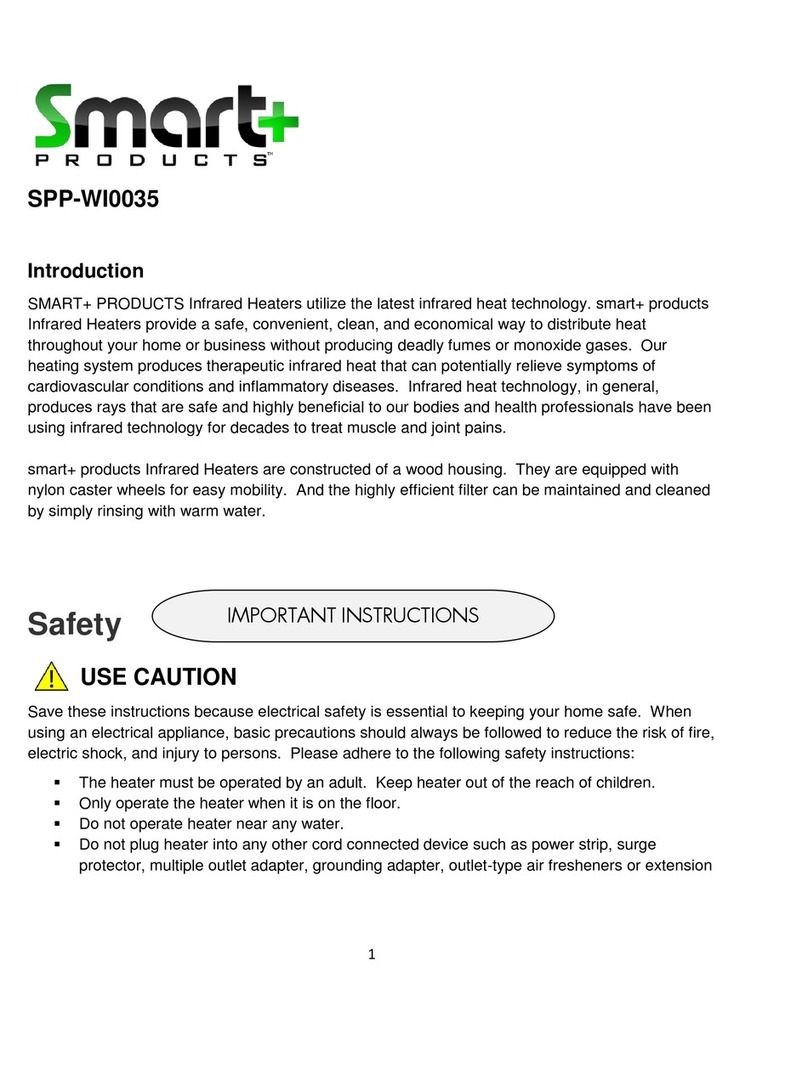
Smart+ Products
Smart+ Products SPP-WI0035 User manual
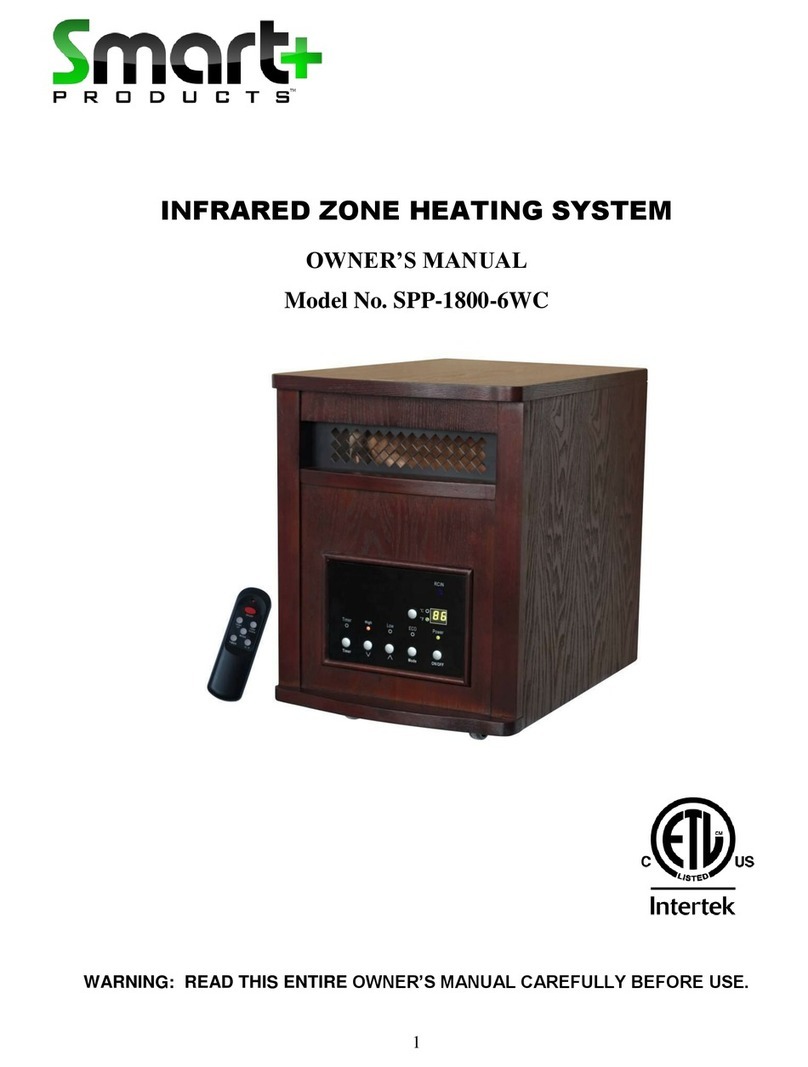
Smart+ Products
Smart+ Products SPP-1800-6WC User manual
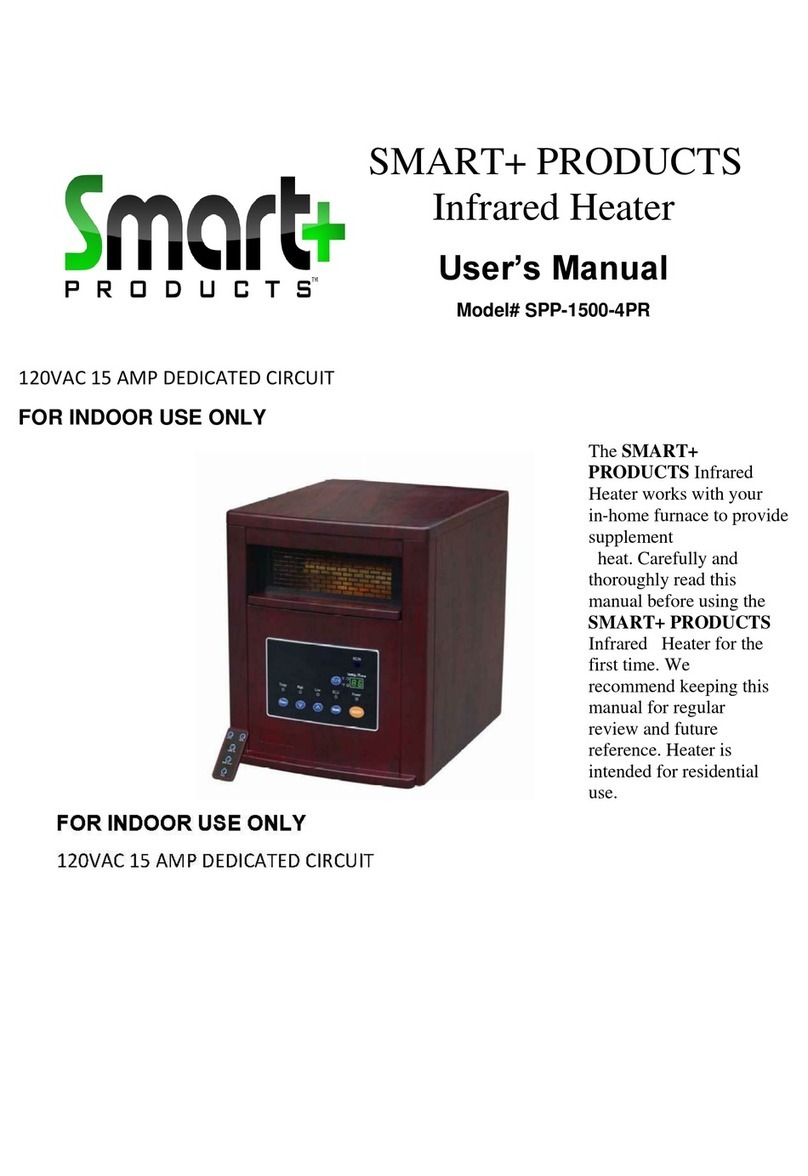
Smart+ Products
Smart+ Products SPP-1500-4PR User manual
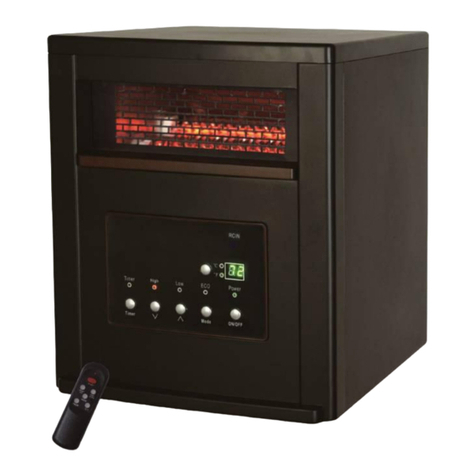
Smart+ Products
Smart+ Products SPP-4PC-1000 User manual
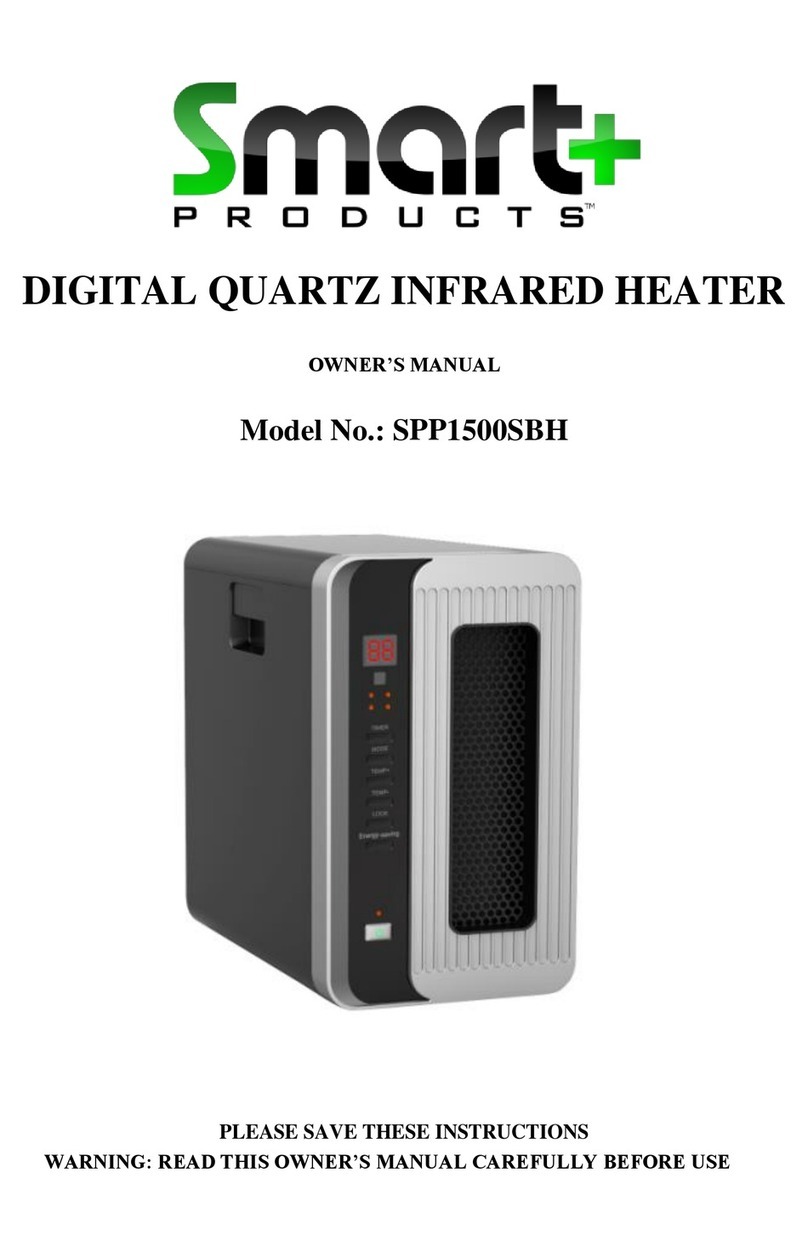
Smart+ Products
Smart+ Products SPP1500SBH User manual
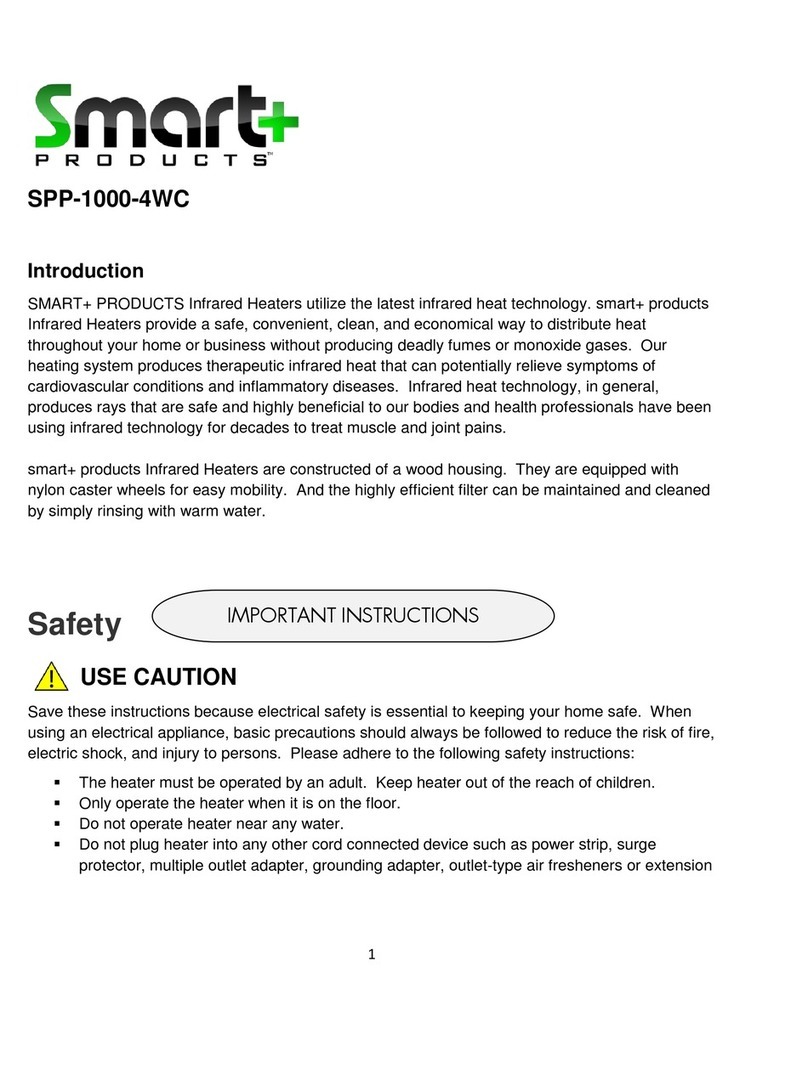
Smart+ Products
Smart+ Products SPP-1000-4WC User manual
Popular Heater manuals by other brands
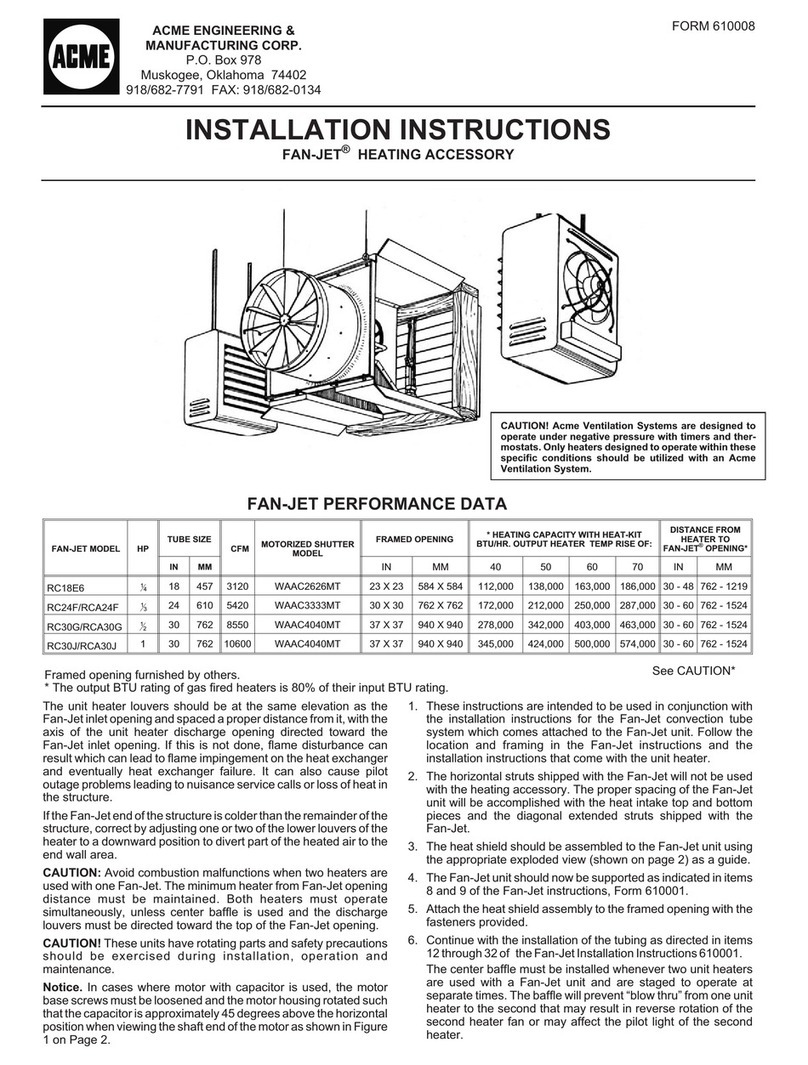
ACME
ACME FAN-JET installation instructions
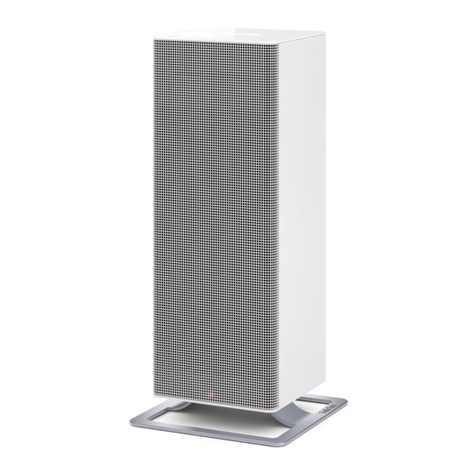
Stadler Form
Stadler Form Anna big operating instructions

CORONA
CORONA XL-DK operating instructions

Olimpia splendid
Olimpia splendid CALDODESIGN Instructions for installation, use and maintenance

Heinner
Heinner HRH-1600GRY instruction manual
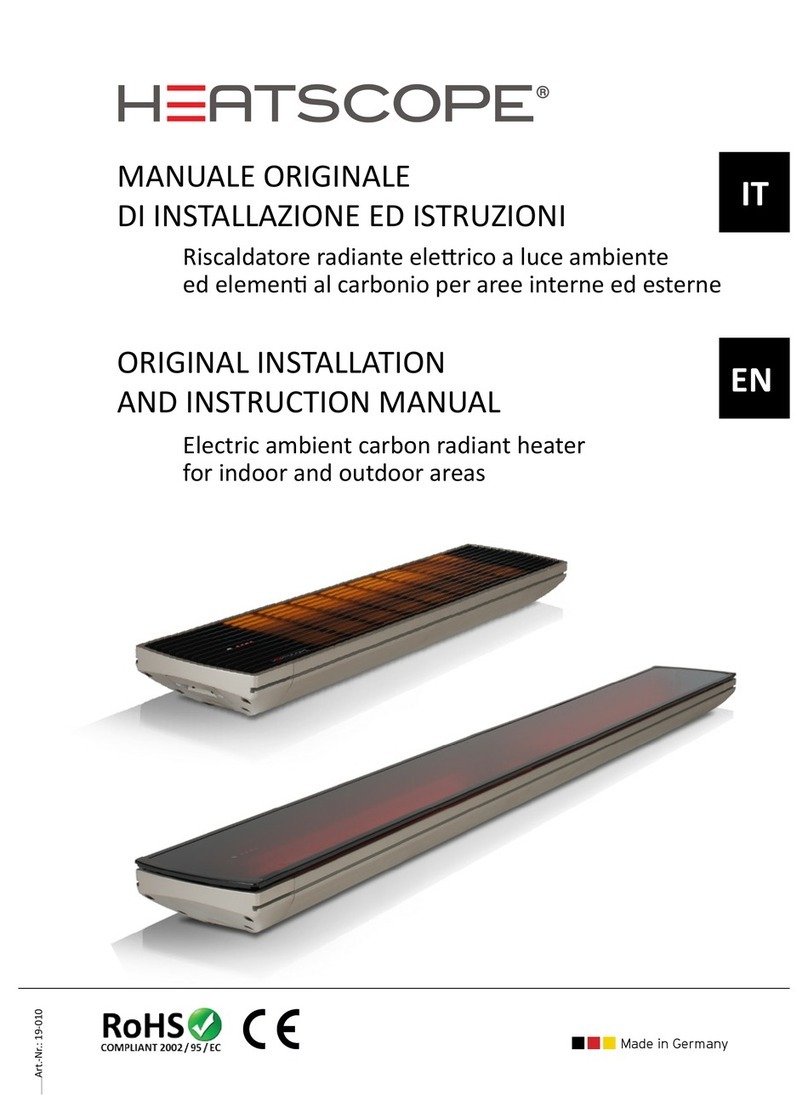
Heatscope
Heatscope Spot Original installation and instruction manual
